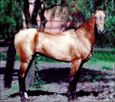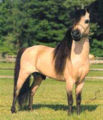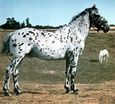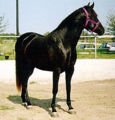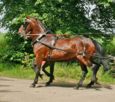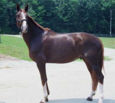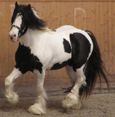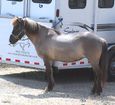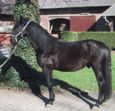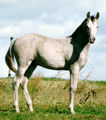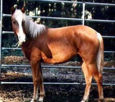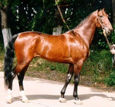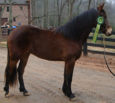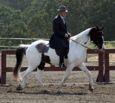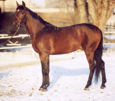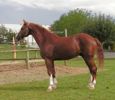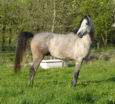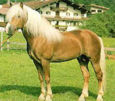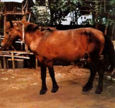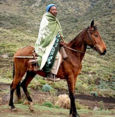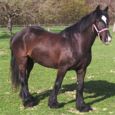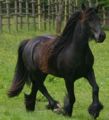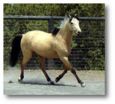|
|
| Line 198: |
Line 198: |
| | Image:Strawberryroan.jpg|'''Strawberry Roan''' <br> WikiCommons | | Image:Strawberryroan.jpg|'''Strawberry Roan''' <br> WikiCommons |
| | Image:BlueDun.jpg|'''Blue Dun''' <br> overmywaders.com | | Image:BlueDun.jpg|'''Blue Dun''' <br> overmywaders.com |
| − | Image:ImageNeeded.png|'''Breed''' | + | Image:Yellowdun.jpg|'''Yellow Dun''' <br> WikiCommons |
| | <--Add more breeds here--> | | <--Add more breeds here--> |
| | | | |
Revision as of 15:29, 26 June 2009
Overview
- Some of the breeds noted below come in a variety of colours. Where this is the case the picture is labelled with 'Various Colours'. Where possible the size of the horse has also been indicated.
Horses
Akhal-Teke
(Various Colours)
15.1-15.2hh
WikiCommons
American Bashkir Curly
(Various Colours)
14.2-15.2hh
WikiCommons
American Cream Draught
16.2hh
WikiCommons
American Miniature
34" to tip of mane hair
worldofhorses.co.uk
American Paint
(Various Patterns)
16hh
WikiCommons
American Saddlebred
(Various Colours)
15-17hh
worldofhorses.co.uk
American Quarter
(Various Colours)
14.3-15.3hh
WikiCommons
Andalusian
(Various Colours)
15.2-16hh
WikiCommons
Angloarab
(Chesnut, Bay or Brown)
15.3-16.3hh
WikiCommons
Appaloosa
(Various Patterns)
14.2-15.2hh
worldofhorses.co.uk
Australian Stock
(Various Colours)
15-16hh
WikiCommons
Azteca
(Various except Appaloosa)
14-15hh
worldofhorses.co.uk
Barb
(Various Colours)
14-15hh
WikiCommons
Brumby
(Various Colours)
14-15hh
WikiCommons
Budenny
(Chestnut, Bay or Brown)
15.2-16hh
worldofhorses.co.uk
Canadian
(Black, Chestnut, Bay or Brown)
14-16hh
WikiCommons
Cleveland Bay
15.2-16hh
WikiCommons
Colorado Ranger
(Any colour, often spotted)
14.2-16hh
worldofhorses.co.uk
Criollo
(Various colours, dorsal stripe)
14-15hh
worldofhorses.co.uk
Danish Warmblood
(Black, chestnut, bay or brown)
15-17hh
worldofhorses.co.uk
Dutch Warmblood
(Chestnut,bay,black,grey, white often on face and legs)
approx 16.2hh
WikiCommons
Finnish Draught
Approx 15.2hh
WikiCommons
Florida Cracker
(Various Colours)
Approx 14-15hh
worldofhorses.co.uk
Friesian
Approx 14.3-15.3hh
WikiCommons
Hanoverian (German)
(All solid colours)
Approx 15.3-16.2hh
WikiCommons
Holsteiner (German)
(Black points)
Approx 16-17hh
worldofhorses.co.uk
Gypsy Vanner
(Piebald and Skewbald)
Approx 14-15.2hh
WikiCommons
Hackney Horse
(Bay,chestnut,brown or black)
Approx 14.3-15.3hh
WikiCommons
Haflinger
(chestnut,flaxen mane and tail)
Approx 14hh
WikiCommons
Hungarian
(All solid colours)
16-17hh
equestrianhomesnw.com
Icelandic Horse
(Various Colours)
12-15hh
WikiCommons
Irish Draught
(Bay,brown,chestnut,grey)
15-17hh
WikiCommons
Kentucky Mountain Saddle
(Any solid colour)
Approx 13.1-16hh
WikiCommons
Kladruber
(Grey or black)
16.2-17.2hh
WikiCommons
Knabstrup
(brown or black spots on white)
Approx 15.2hh
worldofhorses.co.uk
Lippizaner
15.2-16hh
WikiCommons
Lusitano
(Usually grey but any solid colour)
15-16hh
WikiCommons
Mangalarga Marchado
(Usually grey)
Approx 15hh
WikiCommons
Marwari
(Brown,bay,chestnut)
Up to 14.3hh
WikiCommons
Missouri Fox Trotting
(Various Colours)
14.2-16.2hh
WikiCommons
Morab
(Various Colours except spotted)
14.1-15.2hh
worldofhorses.co.uk
Morgan
(No white above knee)
14.1-15.2hh
WikiCommons
Mustang
(Various Colours)
14-15hh
worldofhorses.co.uk
Norweigan Fjord
(Silver and black mane and tail)
13-14.2hh
WikiCommons
Oldenburg (German)
(Brown, black and bay)
16-17hh
WikiCommons
Orlov
(Grey or black)
15.2-17hh
worldofhorses.co.uk
Palamino
(Various Shades)
14-17hh
WikiCommons
Peruvian Paso
(Bay and Chestnut most common)
14-15.2hh
worldofhorses.co.uk
Pinto
14.2-15.2hh
WikiCommons
Russian Don
(Chestnut or Brown)
15.2-16.2hh
WikiCommons
Russian Trotter
(Bay,Chestnut,Brown,Grey)
15.3-16hh
worldofhorses.co.uk
Error creating thumbnail: File missing
Selle Français
(Mainly Chestnut)
15.2-17hh
WikiCommons
Spanish Norman
(Grey,Bay,Black)
15.3-17hh
thegoodhorse.com
Spotted Saddle
(Two Colours Mixed)
14.3-16hh
WikiCommons
Standardbred
(Bay,brown,chestnut)
Approx 15.3hh
WikiCommons
Swedish Warmblood
(Bay,Chestnut,Brown,Grey)
Approx 16.2hh
WikiCommons
Tennessee Walking
(Chestnut and Black)
15-16hh
WikiCommons
Tersk
Approx 15hh
worldofhorses.co.uk
Trakehner
(Any Solid Colour)
16-16.2hh
WikiCommons
Welsh Cobb
(Any Solid Colour)
No Upper Limit
WikiCommons
Westphalian
(Any Solid Colour)
15.3-16.2hh
WikiCommons
Horses (Cold-Blood)
Belgian Draft
(Chestnut, Sorrel or Roan)
15.3-17hh
worldofhorses.co.uk
Boulonnais Horse
(Grey, Bay or Chestnut)
15-17hh
WikiCommons
Breton
(Grey, Bay or Chestnut)
14.3-16.3hh
WikiCommons
Clydesdale
(Bay, Brown or Black)
17.1-18hh
WikiCommons
Comtois
(chestnut, flaxen mane and tail)
14-15hh
WikiCommons
Percheron
(Usually grey or black)
15.2-17hh
WikiCommons
Russian Heavy Draught
(Chestnut, Strawberry roan or bay)
15.2-16.3hh
worldofhorses.co.uk
Shire
(Bay,grey or black)
16-18hh
WikiCommons
Suffolk Punch
Approx 16hh
WikiCommons
Horses (Hot-Blood)
Arabian
(Chestnut, grey, bay and black)
14.2-15.hh
WikiCommons
Shagya Arabian
Approx 15hh
WikiCommons
Thoroughbred
(Any Solid Colour)
15-17hh
WikiCommons
Ponies
Avelignese
13.3-14.3hh
worldofhorses.co.uk
Bali
(Mainly Dun)
13.3-14.3hh
worldofhorses.co.uk
Basuto
(Chestnut, Brown, Bay, Grey)
upto 14.2hh
worldofhorses.co.uk
Camargue
Up to 14h
worldofhorses.co.uk
Chincoteague
upto 12hh
WikiCommons
Connemara
(Grey, black, brown, bay) 12-13hh
WikiCommons
Dales
(Black, brown, bay)
Up to 14.2hh
WikiCommons
Dartmoor
(Various Colours)
Up to 12.2hh
WikiCommons
Eriskay
(Black,bay, grey)
Up to 12-13.2hh
WikiCommons
Exmoor
(Bay,tan)
Up to 11.1-12.3hh
WikiCommons
Falabella
(Various Colours)
Under 9hh
WikiCommons
Fell
(Black,bay,brown,grey)
13-14hh
WikiCommons
Error creating thumbnail: File missing
Galiceño
(Any solid colour)
Up to 14hh
worldofhorses.co.uk
Hackney
(Bay,chestnut,brown or black)
12.2-14.2hh
WikiCommons
Highland
(Dun,grey,brown or black and dorsal stripe)
13-14.2hh
WikiCommons
Hokkaido
(Solid colours, usually roan)
12.2-13hh
WikiCommons
Hucul
(black,bay,chestnut,dun)
12.1-13.1hh
WikiCommons
Kiso
(Various Colours)
Approx 13hh
worldofhorses.co.uk
Konik
(Dun with dorsal stripe)
Up to 13hh
WikiCommons
New Forest
(Various Colours)
Up to 12-14.2hh
WikiCommons
Newfoundland
(Usually Brown)
Up to 11-14.2hh
worldofhorses.co.uk
Noma
Approx 10.3hh
horsehome.info
Pony of The Americas
Up to 14.3hh
WikiCommons
Shetland
(Various Colours)
Up to 10.2hh
WikiCommons
Taishu
(Various Colours)
Up to 12hh
Tarpan
(Dun)
Approx 13hh
worldofhorses.co.uk
Tokara
(Various Colours)
Up to 12hh
WikiCommons
Welsh Mountain Pony (Section A)
(Any Solid Colours)
Up to 12hh
WikiCommons
Welsh Pony (Section B)
(Any Solid Colours)
Up to 13.2hh
worldofhorses.co.uk
Welsh Cob Pony (Section C)
(Any Solid Colours)
Up to 13.2hh
WikiCommons
Yili
(Bay,Chestnut,Black,Grey)
Approx 14hh
worldofhorses.co.uk
Yonaguni
(Usually Chestnut)
Approx 11hh
WikiCommons
Other
Donkey
(Various Colours/Type)
62 Chromosomes
WikiCommons
Przewalski
(Usually dun)
66 Chromosomes
Up to 12-13.2hh
WikiCommons
Zebra
(Various Types)
44 Chromosomes
Up to 15hh
WikiCommons
Horse Passport
Horse Passports (England) Regulations 2004 require all owners to obtain a passport for each horse they own. This includes ponies, donkeys, and other equidae. Owners cannot sell, export, slaughter for human consumption, use for the purposes of competition or breeding, a horse which does not have a passport.^
For further information on filling out a Horse Passport, please see; http://www.horsepassportagency.co.uk
Standard Horse Colours
Principle Colours (Section A - Colours Commonly Occurring in Thoroughbreds):
- Bay : Reasonably clearly defined colour between black lower part of legs and the general tan/brown colour of upper legs and body. Mane and tail are black.
- Brown : Whole coat is brown and no distinguishing colour line between upper and lower leg.
- Black : Whole coat including legs, body, stifle fold and muzzle must be black. Any indication of tan in coat, stifle fold or muzzle should classify horse as brown.
- Chestnut : Coat is reddish or yellowish brown. Mane and tail are chestnut and may be lighter and darker than the body colour.
- Grey : Coat mixture of black and white hairs with black skin. With age coat will turn lighter but still termed grey. Majority of grey horses not grey as foals and should be described by predominant colour at the time but any white hairs should be noted in narrative.
- Roan : Body colour mixture of white, brown or chestnut and intensity variable seasonally. Although acceptable, Roan is rare in Thoroughbreds as most are actually in transition to grey. Roan examples are within the 'Other Colours' section.
Brown
worldofhorses.co.uk
Black
worldofhorses.co.uk
Other Colours (Section B - Acceptable Colours not commonly occuring in Thoroughbreds):
- Blue Roan : Body colour black or black-brown with any mixture of white hairs giving blue tinge. Black hairs usually predominate on head and from knee or hock down. Some white limb markings also may occur.
- Red Roan : Body colour is bay or bay-brown with any mixture of white hairs giving reddish tinge to coat. Bay hairs usually predominate head. From knees or hock below black usually predominates although white markings may occur.
- Strawberry or Chestnut Roan : Body colour is chestnut with any mixture of white hairs. Chestnut usually predominates head and below knees or hock. White markings may be encountered.
- Blue Dun : Body colour between slate grey to light stone and always evenly distributed. Mane and tail are black. May or may not be dorsal stripe along back and/or withers. Skin is black.
- Yellow Dun : Diffuse yellow pigment in hair. May or may not be dorsal stripe along back and/or withers and bars on legs. Striping usually associated with black pigment on head and limbs. Black skin.
- Cream : Body colour is cream with unpigmented skin. Iris is deficient in pigment giving eye pinkish or bluish appearance.
- Piebald : Body colour has large irregular patches of black and white. Demarcation of colours well defined.
- Skewbald : Body colour has large irregular patches of white and any definite colour except black. Demarcation of colours well defined.
- Odd Coloured : Body consists of large irregular patches of more than two colours which may merge into each other at edges.
- Palamino : Body is newly-minted gold-coin colour. Lighter/darker patches permissable. White mane and tail.
- Appaloosa : Basic body colour is usually roan with varyinng mosaic of spots. May be dark spots on white, white spots on dark ground. Covers part of all of body.
Strawberry Roan
WikiCommons
Blue Dun
overmywaders.com
White Markings
Any white marking must be outlined in red, lightly hatched in with diagonal lines.
Standard Horse Passport Markings
References
^ Department for Environment, Food and Rural Affairs (DEFRA); http://www.defra.gov.uk/rural/horses/topics/passports.htm
